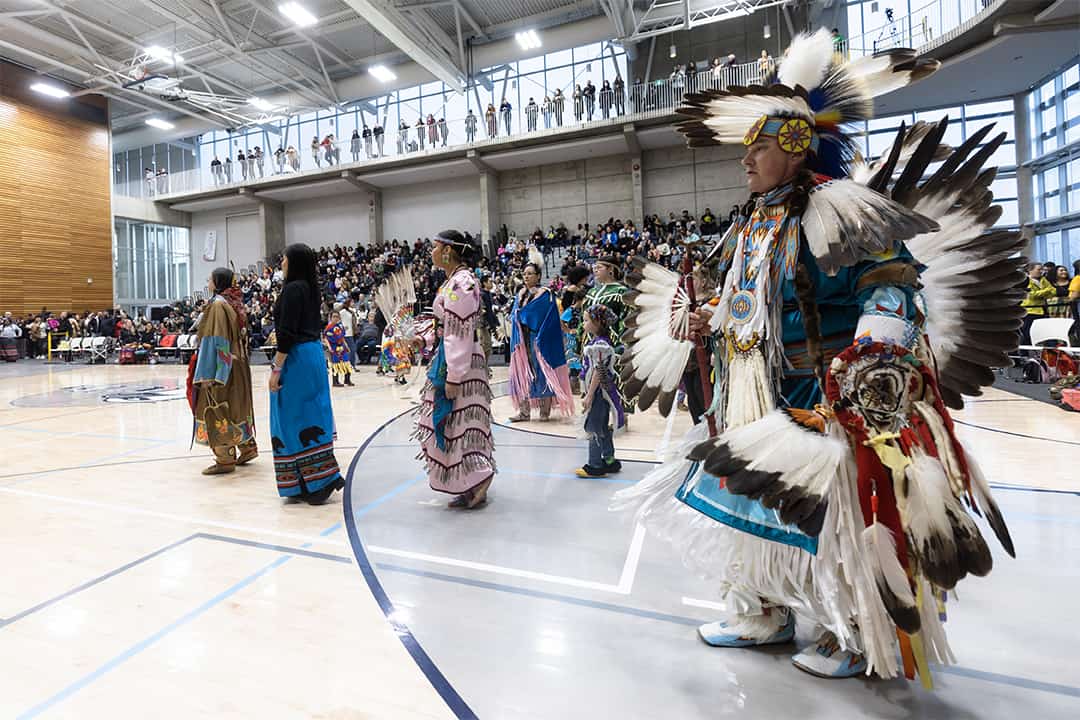On March 25, the UTM Indigenous Centre and the Mississaugas of the Credit First Nation (MCFN) hosted UTM’s inaugural All-Nations Powwow. Around 1,500 people gathered at UTM’s Recreation, Athletics and Wellness Centre (RAWC) for the five-hour long ceremony and celebration.
The public event opened at 12:00 pm with a grand entry ceremony. As the ceremony opened, over 50 Indigenous dancers in full regalia — including head dancers, three first-time dancers, and two dancers with new regalia — entered the main floor of the RAWC gym with eagle staffs and flags. Then, dancers performed the grand entry song, the flag song, and the veteran song, which are all “honour songs,” according to the event’s Master of Ceremonies Bob Goulais, a member of Nipissing First Nation and founder of the Indigenous relations firm Nbisiing Consulting.
“[These songs] have a connection to the spirit,” Goulais said. During these performances, he instructed audience members to not take photographs.
Next, UTM Vice-President and Principal Alexandra Gillespie, Mississauga Mayor Bonnie Crombie, MCFN Chief R. Stacey LaForme, and the UTM Officer of Indigenous Initiatives Director Tee Duke gave opening remarks at the powwow.
In her speech, Crombie said that the City of Mississauga is committed to “truth and reconciliation” and it will “continue its efforts to recognize and advocate for all Indigenous communities.” Some MPs, MPPs, ministers, councillors, and mayors were also in attendance.
The powwow included the Tia Lyn Copenance Jingle Dress Special, in which more than 30 jingle dress dancers performed three rounds of dances. Judges then chose the top five dancers, who were awarded with cash prizes and merchandise.
The jingle dress is the traditional dress of the Anishinaabe people. “It’s the dress that was brought to us for healing, for wellness, to make sure we are ready to take care of ourselves,” Goulais said.
The Duke and Copenance family held and sponsored the dance special in honour of Tia Lyn Copenance — one of Duke’s sisters — who had recently undergone a severe illness but was able to recover.
The powwow also featured intertribal, spot, and exhibition dances. During intertribal and spot dances, audience members joined Indigenous performers on the main stage to dance. Eighteen Indigenous-owned businesses and seven Indigenous-led information booths tabled at the event as well.
Tamara Cochrane is from the MCFN herself and is the cultural awareness coordinator with The Moccasin Identifier — a program aimed to raise awareness and educate about treaties and Indigenous peoples. The Moccasin Identifier, in part, provides educational and stencil kits for drawing moccasins in public spaces.
Cochrane told The Varsity that when she was younger, she did not feel “connected” to her Indigenous culture and language, but she learned more by participating in powwows. “Every time I come [to a powwow], I learn something new,” she said. “It’s very healing.”
She said that being able to hold powwows is a “big deal” for many Indigenous people, and added, “There was once a time where we weren’t allowed to speak our language or participate in our culture at all.” The 1876 Indian Act banned Indigenous ceremonies and dance — including powwows — until 1951.
Cochrane said that she feels encouraged to see Indigenous peoples from different Nations coming together and to see non-Indigenous people participating in powwows and wanting to learn more about Indigenous histories and traditions.


